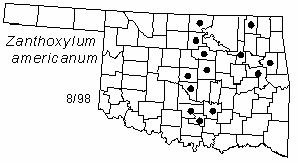Thicket-forming shrub to 3 m (9 ft) in height (rarely a small tree to 6 m tall). Crown many-branched. Bark gray to brown, smooth. Twigs red-brown to gray, pubescent when young, glabrous with age, unarmed or with paired spines 5-15 mm (1/5-3/5 in) long. Leaves alternate, pinnately compound, with 5-11 leaflets. Leaflets elliptic, ovate or oblong, 2-7.5 cm (0.8-3 in) in length, 1-3.5 cm (0.4-1.5 in) wide; pubescent, becoming glabrous; dull green above, veins impressed, paler beneath; asymmetrical base; obtuse at apex; margins crenate or entire; lateral leaflets sessile, terminal leaflet on short petiole; rachis pubescent, becoming glabrous with age. Inflorescence an axillary cyme of small, inconspicuous flowers, pedicels slender and pubescent; calyx absent; petals 5, rounded at apex; pistils 3-5, styles slender, ovules 2; stamens 5, exserted; flowers appear from April to May. Fruit a follicle, 4-5 mm (1/6-1/5 in) long, subglobose to ellpsoid, green to red-brown; seeds 1-2; fruits are strongly aromatic; matures July to September.
Distribution: Oklahoma and Kansas, north to North Dakota, east to Minnesota and Virginia, south to Georgia and Kentucky. Uncommon.
Habitat: moist valleys and river bottoms.
Comment: Zanthoxylum is a Greek word meaning "yellow wood"; americanum refers to North America.
Medicinal uses: fluidextractum xanthoyli is the trade name for a pungent resin extracted from the fruit and bark. Although an irritant, it is used for rheumatism, as a gastro-intestinal stimulant in flatulence and diarrhea, masticatory for toothache.
Horticulture: Although introduced to cultivation in 1740, toothache tree is only used ocassionally as an ornamental. Propagation by seed requires either stratification for 10 days at 41°F or sowing in fall. Toothache tree can also be propagated by root cuttings and suckers.
Food uses: used as a honey plant.
Wildlife uses: fruits are eaten by bobwhites, vireos, pheasants, cottontails and eastern chipmunks.
NWI status: none
Distribution in Oklahoma: 
BACK
NEXT
RETURN TO INDEX
Last update: 9/23/99
 Go to Oklahoma Biological Survey Home Page
Go to Oklahoma Biological Survey Home Page
 Disclaimer
Disclaimer